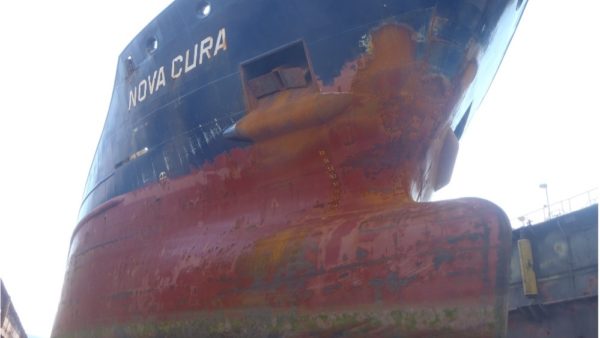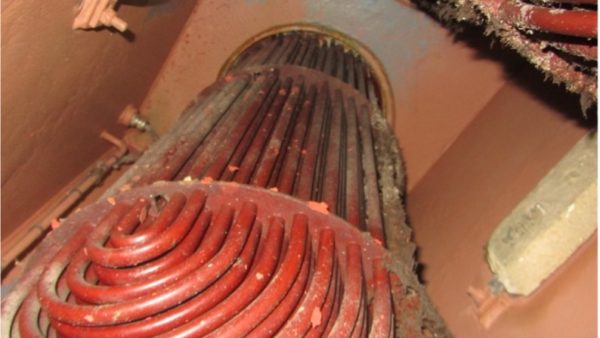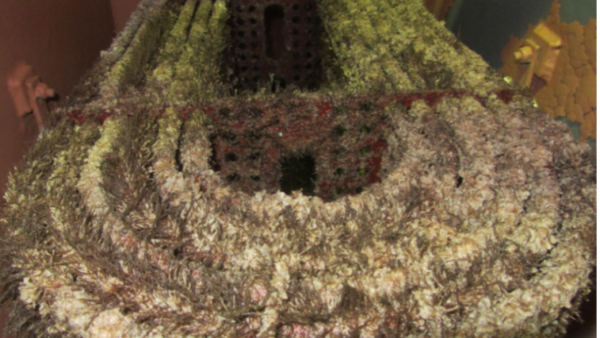Shipping

Ultrasonic transmitters prevent fouling of ship's hull
Ultrasonic systems are used on ships to keep the ship's hull and the bunker coolers free of hard fouling such as barnacles, mussels and oysters. The larvae of these barnacles, mussels and oysters do not want to stay in the vicinity of an ultrasonic transmitter and there is a logical reason for this. Our ultrasonic transmitters cause cavitation and larvae do not like that.
We have carried out a test on the Nova Cura, which you can see on the photo above, on this ship a test was carried out during 6 months, reports can be provided. The Nova Cure was taken out of the water 2 years later in Montenegro and was still free of fouling.
What is cavitation?
Cavitation is the formation of gas bubbles between water molecules. These gas bubbles continue to grow due to the sustained ultrasound and become unstable at a certain size and then these bubbles implode. The imploding causes pressure waves of 2,000 bar and for larvae this looks like strongly flowing water, which is not a place where larvae want to attach themselves. For barnacles, mussels and oysters it is difficult to feed in strong running water. The larvae will therefore look for another place to attach. Our ultrasonic transmitters work preventively in shipping, because they constantly transmit at times when ships are in port.
Ultrasonic in combination with "Easy release coating".
In Fort Lauderdale in America, a test was carried out in which it was demonstrated that the combination of ultrasonic with 'easy release coating' produces an extra good result. Only slime and micro-algae were present on the test panels. With fouling, micro-algae are not the main problem and slime is partly removed by sailing.
Ultrasonic in the box coolers
In 2017, a test was carried out to determine whether the box coolers of a ferry could be kept free of fouling. On the port side, normally the side with the most fouling, the ultrasonic transmitters were mounted, on the starboard side no transmitters were mounted. After 11 months, the box cooler on the port side was clean from fouling, thus retaining its full cooling capacity. The starboard side had fouled up. The pictures below show the situation after 11 months. On this ferry no copper ionisation or other forms of protection were present.
Considerably less noise at sea
Ultrasonic anti-fouling transmitters should only be switched on when a ship is stationary. This can be done automatically. If a ship has ultrasonic transmitters, no extra sound is produced when the ship is sailing. In fact, the use of ultrasonic creates a smooth ship's hull which has less resistance than when there is fouling, so the noise at sea will decrease considerably. Especially the turbulence that hard fouling causes and the extra power that has to be delivered by the propeller, the engines and the propeller shaft causes extra noise during sailing.
Does ultrasound affect marine mammals?
The US Navy has conducted tests with our USAF transmitters, which have shown that the pressure waves have no effect on larger organisms such as fish. Even marine mammals, which communicate through ultrasound, and turtles showed no reaction and no adverse effects.
Benefits of using ultrasonic transmitters in shipping:
No fouling from hard fouling. (Mussels/cocks)
Enormous fuel savings (according to TNO up to 69%)
The boat's top speed is maintained and engines produce less noise.
Easy to use, can be started automatically.
Bunker coolers work much better and more efficiently.
Environmentally friendly way.


